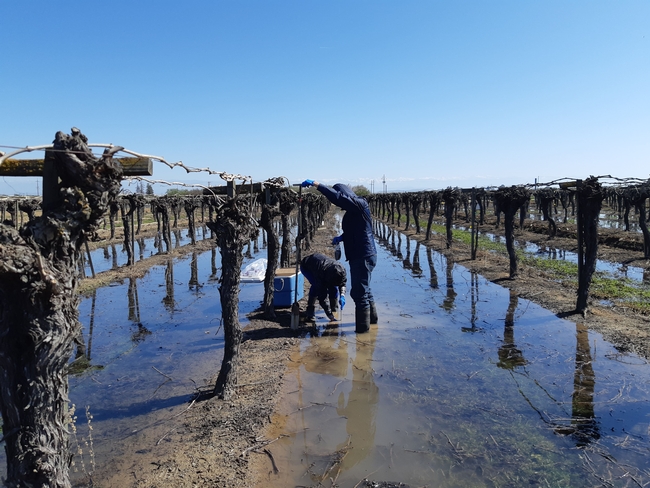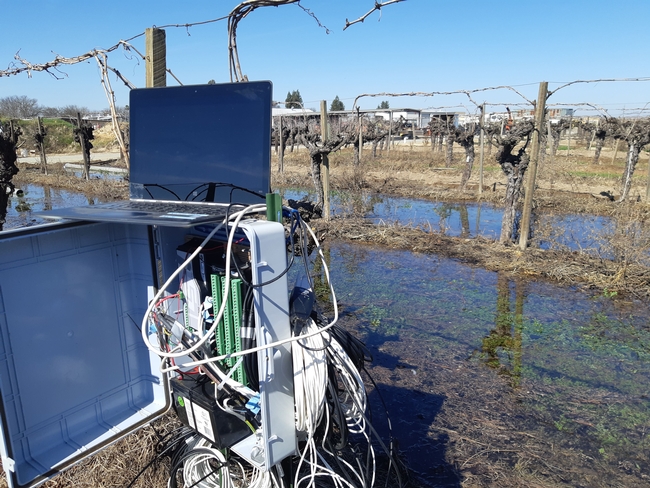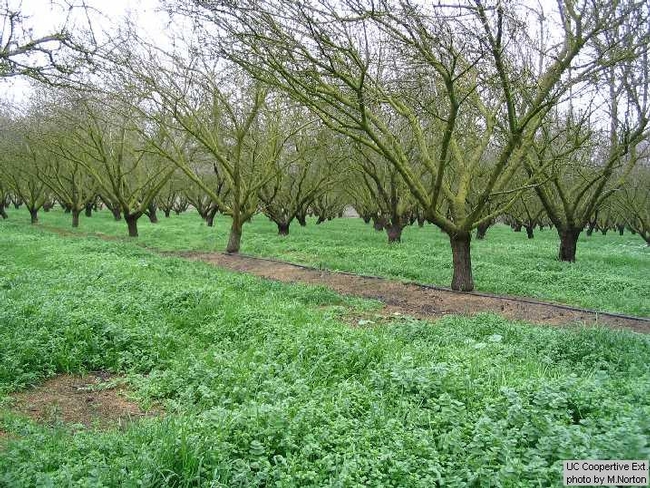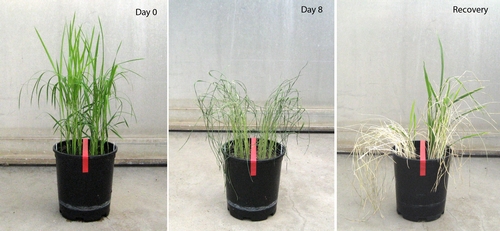Posts Tagged: flood
Study offers insights on reducing nitrate contamination from groundwater recharge
Light irrigation before flooding stimulates microbes to remove nitrates from soil
With California enduring record-breaking rain and snow and Gov. Gavin Newsom recently easing restrictions on groundwater recharge, interest in “managed aquifer recharge” has never been higher. This process – by which floodwater is routed to sites such as farm fields so that it percolates into the aquifer – holds great promise as a tool to replenish depleted groundwater stores across the state.
But one concern, in the agricultural context, is how recharge might push nitrates from fertilizer into the groundwater supply. Consumption of well water contaminated with nitrates has been linked to increased risk of cancers, birth defects and other health impacts.
“Many growers want to provide farmland to help recharge groundwater, but they don't want to contribute to nitrate contamination of the groundwater, and they need to know how on-farm recharge practices might affect their crops,” said Matthew Fidelibus, a University of California Cooperative Extension specialist in the UC Davis Department of Viticulture and Enology.
A recently published study by UC scientists sheds new light on how nitrates move through an agricultural recharge site and how growers might reduce potential leaching. Researchers analyzed data from two grapevine vineyards at Kearney Agricultural Research and Extension Center in Fresno County – one flooded for two weeks, and other for four.
Understanding initial nitrate levels crucial
A key factor in mitigating contamination is understanding how much nitrate is in the soil at the outset, said study author Helen Dahlke, a UC Davis hydrologist and leader of UC Agriculture and Natural Resources' strategic initiative on water. In areas with little precipitation and cropping systems that require greater amounts of synthetic fertilizer, the accumulation of residual nitrate – resulting from nitrogen in the fertilizer not taken up by the plants – can be quite high.
“The percentage of nitrates in some soils can really increase over the years, particularly if you have many dry years in a row where you don't have access to irrigation water or natural precipitation flushing some of those nitrates out of the soil,” Dahlke said.
While intense rains in recent weeks have helped dilute nitrate concentrations naturally, farmers looking to participate in recharge during the dry years ahead should consider flooding their fields with greater volumes of water.
“If you're doing this for the first time – on-farm recharge in the winter – check your residual soil nitrate levels because if they're very high, you should apply a lot of water in order to make sure that the residual nitrate is diluted down,” said Dahlke, who also added that growers should check their soil properties for suitability of recharge projects.
She recommended using, as a “good first approximation,” the online Soil Agricultural Groundwater Banking Index map, a project led by Toby O'Geen, a UC Cooperative Extension soil resource specialist.
Researchers looking at other ways to reduce nitrates
Even before flooding the fields for recharge, there are several practices that can lower initial nitrate levels and risk of leaching. Cover crops such as alfalfa and triticale, for example, can help take up residual nitrates that accumulate from fertilizing a main crop over time.
Dahlke and Fidelibus – a co-author of the San Joaquin Valley vineyard study – both pointed to pre-flooding irrigation that encourages denitrification, a process in which soil microbes transform nitrates into gaseous forms of nitrogen.
“Those denitrifying microbes need to be stimulated to do the work,” said Dahlke. “What we have found is that if you do a little bit of irrigation before you start the flooding, increasing the soil moisture can get those microbes started and they can take out more nitrate from the soil.”
The timing and quantity of fertilizer applications are also major factors in reducing leaching. Although more growers are following high-frequency, low-concentration practices to maximize uptake by crops, Dahlke said there needs to be more emphasis on incorporating nitrogen transformation processes – such as denitrification – in the nutrient management guidelines that farmers follow.
“Implementing thoughtful nutrient management plans will play a particularly important role in participating farms,” Fidelibus added.
A more holistic view of groundwater recharge
In short, choices made during the growing season can affect those in the winter recharge season – and vice versa. For example, applying compost or other organic amendments to soil can give microbes the “fuel” they need for sustained denitrification.
“What we have found is that our denitrifying bacteria often run out of steam because they don't have enough carbon to do the work,” Dahlke said. “Like us, microbes need energy to do the work, and for microbes this energy comes from soil carbon.”
Then, adding moisture via recharge to that field with high organic content can stimulate mineralization and nitrification, processes in which microbes transform the organic nitrogen into ammonium – and subsequently nitrates – that the plants can then take up. Those naturally occurring nitrates would thus reduce the need for the grower to apply synthetic fertilizer.
“The winter on-farm recharge experiments have shown that altering the moisture regime in the winter has consequences for the nitrogen budget in the summer growing season,” Dahlke explained. “Theoretically, what we need to be doing is better integrating both seasons by keeping an eye on the soil-nitrogen balance across the whole year so that we can ensure, at the end of the growing season, the residual nitrate in the soil is minimized.”
The study, published in the journal Science of The Total Environment, was part of the post-doctoral work of former UC Davis researcher Elad Levintal. In addition to Fidelibus and Dahlke, other authors are Laibin Huang, Cristina Prieto García, Adolfo Coyotl, William Horwath and Jorge Rodrigues, all in the Department of Land, Air and Water Resources at UC Davis.
Flood irrigation may help recharge aquifers
UC Agriculture and Natural Resources experts are studying the effectiveness of flood irrigation to help recharge underground aquifers that have been depleted due to the drought, reported Ken Carlson in the Modesto Bee.
The pilot research project will involve flood irrigating almond orchards during the winter months, according to Roger Duncan, UC ANR Cooperative Extension advisor in Stanislaus County.
"If it works well, we can expand and potentially look at other locations, other soil types and other cropping systems," Duncan said.
The Modesto trial will take place on one orchard with 10 to 15 acres of fairly sandy soil with groundwater from another area.
According to the article, commercial almond orchards are not usually irrigated in winter because there's enough rainfall to keep the ground moist. Flood irrigation in almonds has of late been regarded as a wasteful practice from the era of cheap and plentiful water; many farmers have turned to micro sprinklers and drip irrigation for water conservation. But orchard flooding could bounce back as a strategic tool as local jurisdictions try to manage their groundwater levels.
Swaying both ways
Imagine if rice – yes, that semiaquatic species that is typically cultivated under partially flooded conditions – could be both flood- and drought-tolerant. Such a rice variety would benefit rice growers and consumers worldwide and would be less vulnerable to weather extremes that may result from global climate change.
Now UC Riverside experiments demonstrate that such rice is already here. Genetics professor Julia Bailey-Serres’ research group reports in a recent issue of The Plant Cell that flood-tolerant rice is also better able to recover from drought.
“Flood tolerance does not reduce drought tolerance in these rice plants, and appears to even benefit them when they encounter drought,” Bailey-Serres says.
She and her team – Takeshi Fukao, a senior researcher, and Elaine Yeung, an undergraduate student – focused on Sub1A, a gene responsible for flood or “submergence” tolerance in rice. Sub1A works by making the plant dormant during submergence, allowing it to conserve energy until the floodwaters recede. Indeed, rice with the Sub1A gene can survive more than two weeks of complete submergence.
Plant breeders have already profited farmers worldwide – especially in South Asia – by having transferred Sub1A into high-yielding rice varieties without compromising these varieties’ desirable traits — such as high yield, good grain quality, and pest and disease resistance.
Bailey-Serres’s lab found that in addition to providing robust submergence tolerance, Sub1A aids survival of drought. The researchers report that at the molecular level Sub1A serves as a convergence point between submergence and drought response pathways, allowing rice plants to survive and re-grow after both weather extremes.
“Sub1A properly coordinates physiological and molecular responses to cellular water deficit when this deficit occurs independently, as in a time of drought, or following ‘desubmergence,’ which takes place when flood waters recede,” says Bailey-Serres who was the lead recipient of the 2008 USDA National Research Initiative Discovery Award.
Next, her colleagues at the International Rice Research Institute in the Philippines will test the Sub1A rice for drought tolerance in the field. What are some other implications of this research? One that comes to mind is that the “Got Rice?” slogan might have to drop the question mark, and put in its place a solid period!




